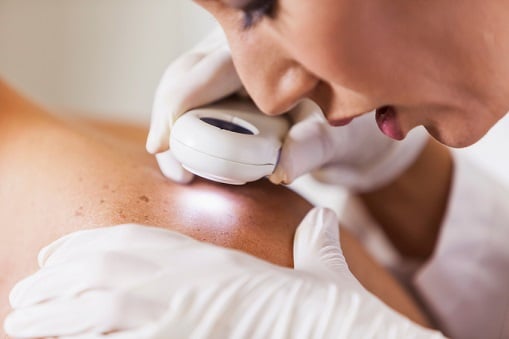The inventors aim to create a low-cost handheld scanner to painlessly diagnose skin cancer

Given the potential risks from skin cancer, developing a way to detect the disease early is critical. Different methods and technologies are available to screen for skin cancer, but the ideal test should be painless, simple, and cheap — exactly what a prize-winning group of inventors aimed for.
Beating more than 1,000 ideas from around the world, a team of engineering graduates from McMaster University recently clinched the James Dyson Award for design engineering with their prototype of a handheld skin-cancer detector, reported CBC News.
Their device, called the sKan, has “the potential to save lives around the world,” said James Dyson, inventor and founder of the James Dyson Foundation.
The typical method of diagnosing skin cancer starts with visual inspection by a doctor. If they find a lesion or mole that looks suspicious, they can confirm or rule out cancer by cutting out a piece of the skin. According to one study, more than 60 biopsies were done for every melanoma detected in the US between 1986 and 2001.
The sKan device is meant to detect skin cancers painlessly by determining how quickly a patch of human skin warms back up after being cooled; cancerous lesions heat up faster than normal skin or moles. According to Dr. Raimond Wong, the sKan team’s mentor and chairman of the Gastrointestinal Oncology Site group at the Juravinski Cancer Centre, that’s because cancer cells have a higher metabolic rate, and they attract blood vessels that provide them with extra energy.
While that idea has seen some success with infrared cameras, those devices can cost thousands to tens of thousands of dollars. The sKan detector hopes to do that more cheaply using thermistors — components that change their electrical resistance with temperature — arranged in a grid pattern.
“The pieces that we're using you can get for like $1 apiece,” said 22-year-old Rotimi Fadiya, a member of the sKan team. Smaller, more sensitive thermistors are also available for $10 or $20, he said.
It has tremendous potential, but sKan has a long way to go. The prototype can only detect temperature differences of 0.6OC between two locations; to diagnose melanoma, it needs to register a 0.3OC difference. And it has only been tested on a gel in a lab, not on real human skin.
But Fadiya is confident that the team can improve the design. With their prize money worth $51,000 (US$40,000), they plan to come up with a better prototype with more sensitive thermistors. They also hope to get their prototype in doctors’ offices, where it can be tested on actual patients’ skin.
Related stories:
Ontario urged to step up on take-home cancer treatments
Childhood cancer survivors more prone to disease than average people
Beating more than 1,000 ideas from around the world, a team of engineering graduates from McMaster University recently clinched the James Dyson Award for design engineering with their prototype of a handheld skin-cancer detector, reported CBC News.
Their device, called the sKan, has “the potential to save lives around the world,” said James Dyson, inventor and founder of the James Dyson Foundation.
The typical method of diagnosing skin cancer starts with visual inspection by a doctor. If they find a lesion or mole that looks suspicious, they can confirm or rule out cancer by cutting out a piece of the skin. According to one study, more than 60 biopsies were done for every melanoma detected in the US between 1986 and 2001.
The sKan device is meant to detect skin cancers painlessly by determining how quickly a patch of human skin warms back up after being cooled; cancerous lesions heat up faster than normal skin or moles. According to Dr. Raimond Wong, the sKan team’s mentor and chairman of the Gastrointestinal Oncology Site group at the Juravinski Cancer Centre, that’s because cancer cells have a higher metabolic rate, and they attract blood vessels that provide them with extra energy.
While that idea has seen some success with infrared cameras, those devices can cost thousands to tens of thousands of dollars. The sKan detector hopes to do that more cheaply using thermistors — components that change their electrical resistance with temperature — arranged in a grid pattern.
“The pieces that we're using you can get for like $1 apiece,” said 22-year-old Rotimi Fadiya, a member of the sKan team. Smaller, more sensitive thermistors are also available for $10 or $20, he said.
It has tremendous potential, but sKan has a long way to go. The prototype can only detect temperature differences of 0.6OC between two locations; to diagnose melanoma, it needs to register a 0.3OC difference. And it has only been tested on a gel in a lab, not on real human skin.
But Fadiya is confident that the team can improve the design. With their prize money worth $51,000 (US$40,000), they plan to come up with a better prototype with more sensitive thermistors. They also hope to get their prototype in doctors’ offices, where it can be tested on actual patients’ skin.
Related stories:
Ontario urged to step up on take-home cancer treatments
Childhood cancer survivors more prone to disease than average people



